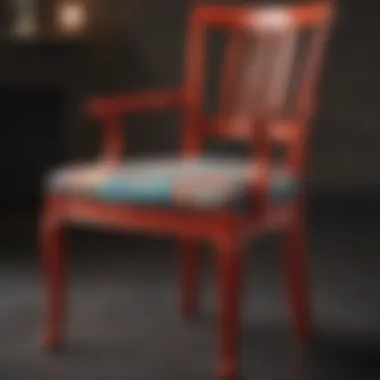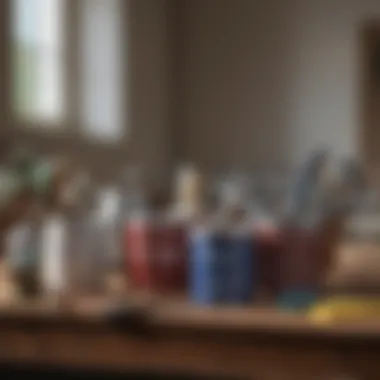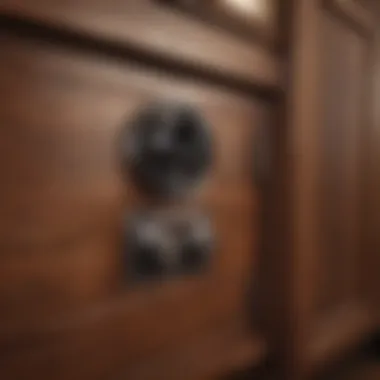Refinishing Wood Furniture with Paint: A Guide


Intro
Refinishing wood furniture with paint is an engaging endeavor for homeowners and design enthusiasts alike. This process allows individuals to transform ordinary, worn-out pieces into stunning focal points that enhance the aesthetic of living spaces. Whether it is a vintage dresser or a simple chair, the right paint can breathe new life into these items.
Understanding the ins and outs of furniture refinishing is crucial for achieving durable and visually pleasing results. This guide will navigate through essential techniques, materials, and steps that detail how best to approach your furniture projects. Readers will learn to face common challenges while refining their strategies to maintain the beauty of their refinished items effectively.
Understanding the Concept of Furniture Refinishing
Refinishing furniture is a critical topic for homeowners and those interested in interior design. Understanding this concept allows individuals to breathe new life into their wood pieces, transforming tired and outdated furniture into eyecatching centerpieces. Refinishing with paint is more than just a cosmetic improvement. It involves techniques that can enhance the durability and aesthetics of furniture, making it an essential aspect of home maintenance.
Definition and Purpose
Furniture refinishing can be defined as the process of restoring or altering the surface of a piece of furniture. It’s done to improve its appearance, prolong its lifespan, and adapt it to updated home decor. The primary purpose is to refresh wood furniture, which may show signs of wear, damage, or fading from prolonged use. This process also allows for flexibility in design, as choosing a different paint color can significantly alter the mood and style of a room. By understanding the nature of refinishing, individuals can make informed decisions that align with their home’s aesthetics.
Benefits of Refinishing with Paint
Refinishing wood furniture with paint offers several advantages:
- Cost-Effective Solution: Instead of purchasing new furniture, refinishing allows homeowners to reuse existing pieces, saving money in the process.
- Personalization: Painting gives individuals the opportunity to customize furniture to fit specific themes or preferences in their home.
- Environmentally Friendly: By refinishing, one contributes to sustainability by reducing waste and prolonging the life of furniture.
- Increased Value: Properly refinished furniture can enhance its market value, making it more appealing to potential buyers.
According to sources, such as Wikipedia, refinishing is not just about aesthetic changes; it encapsulates a philosophy of reuse and restoration. Thus, engaging with this process aligns well with broader concepts of sustainability and resourcefulness in home improvement.
"Refinishing furniture is as much about preserving heritage as it is about aesthetics and functionality."
This understanding of furniture refinishing sets the stage for deeper exploration into the types of paint suitable for wood, preparation steps, and application techniques. It underscores the value of a thoughtful approach to home furnishings.
Types of Paint Suitable for Wood Furniture
Choosing the right type of paint is essential in the refinishing process of wood furniture. Different paints offer unique benefits and can significantly impact the final look and durability of the project. Each paint type has its own characteristics, making it important to understand these aspects before starting any refinishing work. The right choice can lead to a beautifully finished piece that withstands the test of time. Below, we explore three common types of paint suitable for wood furniture: latex paint, oil-based paint, and chalk paint.
Latex Paint
Latex paint is water-based and recognized for its quick drying time and easy cleanup. This paint is user-friendly and suitable for indoor furniture projects. It has a low odor, making it a favorable option for those concerned about air quality during application. Not only does latex paint adhere well to wood surfaces, but it also comes in a variety of finishes, including matte, satin, and gloss.
Here are some benefits of using latex paint:
- Fast Drying: Generally, it dries in about one hour, allowing for efficient project completion.
- Flexibility: With its elasticity, latex paint is less prone to chipping.
- Safety: The low VOCs (volatile organic compounds) present make it less harmful for indoor use.
However, latex paint can sometimes require a primer for better adhesion, especially on previously varnished surfaces. It is critical to choose a high-quality latex paint for the best results.
Oil-Based Paint
Oil-based paint has been a traditional choice for wood furnishings due to its robust finish. This type of paint offers a rich, deep color and a hard shell once cured. Though slower to dry, oil-based paint provides excellent durability and resistance to wear. Its ability to level out imperfections on the surface often makes it preferable for intricate woodwork.
Consider these points when opting for oil-based paint:
- Longevity: It creates a tougher coating, making it suitable for furniture that sees heavy use.
- Smooth Finish: Ideal for achieving a glass-like appearance, enhancing the wood grain.
- Ideal for Outdoor Use: It withstands the elements well when properly sealed.
Oil-based paint does have downsides. It emits stronger fumes and requires solvents for cleanup. Also, the drying time can extend from hours to days depending on humidity and temperature. This paint may not be the first choice for the novice, but experienced DIYers appreciate its reliability.
Chalk Paint
Chalk paint has gained popularity for its unique matte finish and ease of use. This type of paint is particularly favored for a vintage or distressed look. Its thick consistency allows it to adhere well to almost any surface without extensive preparation. Chalk paint can easily transform furniture, making it an appealing option for rapid redecorating.
Key advantages of using chalk paint include:


- Minimal Prep Work: Often requires no sanding or priming, making it very user-friendly.
- Versatile Finish Options: It can be waxed or sealed to add varying degrees of protection and shine.
- Easily Distressed: Perfect for achieving that shabby chic aesthetic through simple distressing techniques.
On the downside, chalk paint may not be as durable as latex or oil-based options. Without sealing, it might be subject to scratches and wear. Therefore, a good topcoat is often necessary to enhance its longevity.
"Selecting the right paint type is a crucial step in the furniture refinishing process. It influences aesthetics and performance significantly."
In summary, each paint type suits different needs and desired finishes. Understanding these distinctions can lead to more successful furniture refinishing projects.
Preparation Steps Before Painting
Preparing wood furniture before applying paint is a critical phase in the refinishing process. This preparation ensures the final outcome is not only visually appealing but also durable. Rushing through these steps can lead to problems that compromise the quality and longevity of the finish. Therefore, understanding and executing these preparation steps properly is essential.
Choosing the Right Furniture
Selecting the appropriate piece of furniture is the first step in your refinishing journey. Not all furniture will yield the same result when refinished. Consider the type of wood, the existing finishes, and the overall condition. For example, solid wood pieces such as oak or maple are excellent candidates because of their sturdiness and ability to hold paint well. In contrast, particleboard may not fare as well against paint. Assess your furniture carefully. It should be something that has potential for improvement and matches your desired aesthetic.
Cleaning and Removing Existing Finish
Cleaning the surface is crucial prior to any refinishing project. Dust, grease, and grime can prevent paint from adhering properly. Typically, a mixture of warm water and mild soap will suffice in the cleaning process. Use a sponge or cloth to scrub the surfaces. After cleaning, removing the existing finish is next on the agenda. This can be done using a chemical stripper, which can be effective but requires appropriate safety measures. Alternatively, sanding the surface gently can also strip away the old finish. Do ensure all remnants of the previous finish are eliminated. Leaving any behind can lead to uneven paint application, ruining your hard work.
Sanding Techniques for Wood
Sanding is a pivotal step that cannot be overlooked. This process allows you to create a smooth base for the paint application. Begin with a coarse sandpaper,, such as 80-grit, to remove the top layer of wood and finish. Gradually progress to finer grits, ideally 120-grit, and then 220-grit. Sand in the direction of the wood grain to avoid gouges and imperfections. Additionally, use a sanding block for flat surfaces. Remember to wipe away the dust with a damp cloth after sanding to prepare the surface for the primer.
Applying Primer
Priming is an important step that helps facilitate better adhesion of the paint. A good primer can also enhance the finish by preventing the wood's natural tannins from bleeding through. Choose an appropriate primer based on the type of paint you plan to use—some primers are specifically designed to work with latex paints, while others are better suited for oil-based paints. Apply the primer using a brush or roller, ensuring even coverage. It is advisable to let the primer dry completely before proceeding with the paint application process. Testing your paint on a small, inconspicuous area after priming can help you confirm compatibility and finish expectations.
Preparing your furniture properly sets the foundation for a successful refinishing project, enhancing durability and aesthetics.
Applying Paint to Wood Furniture
Applying paint to wood furniture marks a crucial stage in the refinishing process. This step not only transforms the look of the furniture but also enhances its protection against wear and tear. Selecting the correct painting method can impact the durability of the finish and the overall aesthetic appeal. With the right techniques and tools, homeowners can achieve a polished look that aligns with their design preferences while ensuring the piece remains functional for years to come.
Tools Required for Painting
To achieve a successful painting project, the right tools are essential. Each tool has unique characteristics that contribute to the painting process, making effective application possible.
Brushes
Using brushes is a common and effective method for applying paint. Brushes allow for precision, especially in detailed areas. A key characteristic of brushes is their variety; they come in different sizes and bristle types to suit specific needs. For example, natural bristles are typically better for oil-based paints, while synthetic bristles work well with water-based paints.
The unique feature of brushes is their ability to reach tight corners and intricate designs on furniture. This is beneficial for achieving a clean finish. Some disadvantages include that it may take longer than other methods and may leave brush strokes, which some may find undesirable.
Rollers
Rollers are another excellent tool for painting large, flat surfaces. They offer efficiency as they cover broad areas quickly. A standout characteristic of rollers is their ability to apply paint evenly, reducing the chances of uneven spots. For this reason, they are often favored for projects requiring a uniform application.
The unique benefit of rollers is their speed of use, which can save time for those working on multiple pieces of furniture or larger items. However, they may struggle to reach tight angles, making them less effective for detailed work compared to brushes.
Spray Guns
Spray guns represent a more advanced option for applying paint. They allow for a smooth, even coating without brush strokes. A key characteristic of spray guns is their ability to atomize the paint, creating a fine mist that adheres evenly to surfaces. This results in a professional finish that is hard to achieve with brushes or rollers.
However, using a spray gun requires more preparation, as proper ventilation and protective equipment are necessary to ensure safety. Additionally, overspray can be a concern, leading to unwanted paint in surrounding areas, which may create more clean-up work.
Techniques for Even Application
For the best outcomes, consider techniques focused on even application. Start with consistent paint mixing to achieve uniform color and texture. Using long, even strokes helps distribute paint properly. Allow each layer to dry before applying the next, creating a smooth finish. Always observe lighting conditions when painting, as good light helps spot uneven areas.
Proper Drying Times and Conditions


Understanding drying times is essential for successful paint application. Always refer to the specific paint's instructions for recommended drying times, as these may vary. Factors including temperature, humidity, and air circulation can significantly influence drying conditions. Applying paint in well-ventilated areas can enhance drying. Additionally, avoid touching the painted surface until fully dry to prevent marks and blemishes.
Finishing Touches
Finishing touches are critical in the refinishing process. They can determine the durability and appearance of the final product. After painting the wood furniture, these steps help protect the surface and elevate its style. It is essential to give attention to the final details, ensuring that the piece is both functional and visually appealing. By implementing the right finishing techniques, you enhance the overall quality and lifespan of the furniture you've just transformed.
Applying Sealer or Topcoat
Applying a sealer or topcoat is an important step that adds a protective layer to your painted wood furniture. This layer helps resist scratches, moisture, and stains, ensuring the finish remains intact over time. Without a good seal, the paint can chip or fade, leading to a less attractive result.
Polyurethane
Polyurethane is a widely used sealer. Its main characteristic is durability. It creates a robust barrier against wear and tear, making it ideal for furniture that will see regular use. This sealer comes in various finishes — matte, satin, and gloss. Each provides a different level of sheen, allowing for personalization according to preferences.
The unique feature of polyurethane is its strong resistance to chemicals and heat. This makes it popular among homeowners seeking a long-lasting solution for their painted furniture. However, it has some disadvantages, such as a longer drying time and the need for proper ventilation during application due to strong odors.
Wax Finish
Wax finish offers a different avenue of protection. It is known for its rich, warm appearance. Many choose wax for its aesthetic qualities, as it enhances the depth and texture of paint while providing a soft sheen that many find appealing. Wax is easy to apply and reapply, allowing for maintenance without stripping the entire finish.
The distinct feature of wax is its ability to be easily repaired. If the surface gets scratched, a simple reapplication can effectively cover the marks. However, wax may not provide the same level of durability as polyurethane, especially in high-traffic areas. It may require more frequent maintenance, making it less suitable for furniture subjected to daily use.
Final Inspection
Once the sealing is complete, conducting a final inspection is crucial. This involves checking for any imperfections in the paint or the sealant. Look for uneven surfaces, bubbles, or missed spots. It is advisable to touch up any areas that seem lacking, ensuring a polished result.
During the inspection, pay attention to the finish’s consistency. Sometimes, spots may need extra attention. If any issues come to light, make corrective measures promptly. This can save time in the long run and ensure the refinished piece maintains its beauty.
By focusing on these final details, you ensure your refinished wood furniture not only looks great but stands the test of time.
Maintenance of Painted Furniture
Maintaining painted furniture is crucial for preserving its appearance and ensuring longevity. Proper care helps protect the finish, prevents wear and tear, and keeps the furniture looking fresh and vibrant. By adhering to some routine maintenance practices, homeowners can enjoy their refinished pieces for many years.
Cleaning Recommendations
Regular cleaning is essential to prolong the life of painted furniture. Dust and dirt can accumulate, making surfaces look dull. Here are some straightforward practices:
- Use a soft, dry microfiber cloth to dust surfaces weekly.
- For deeper cleaning, mix a small amount of mild soap with warm water. Dampen a cloth with the soapy solution to gently wipe the painted surface. Be careful not to saturate the wood.
- Avoid harsh chemicals or abrasive materials, as these can damage the paint finish.
- Rinse the cloth with clean water to remove soap residue, then dry the surface immediately.
Implementing these cleaning techniques helps maintain the luster of the paint and shields it from grime that can lead to deterioration.
Repairing Scratches and Chips
Despite best efforts, damage can occur. Scratches and chips might appear over time, detracting from the beauty of painted furniture. Quick repair is often enough to maintain the aesthetics. Here are steps to address these issues effectively:
- For minor scratches, use a matching paint marker or touch-up paint suitable for the type of paint used. Carefully apply the paint with a fine brush for precision.
- For deeper chips, sand down the area lightly to prepare it for repainting. Ensure that the surrounding paint is intact, and clean off dust.
- Reapply paint to the chipped area, blending it gently into the surrounding surface. Allow it to dry completely before using the furniture again.
- Consider sealing the area with a clear topcoat to enhance durability and ensure it matches the rest of the furniture.
Timely repairs can prevent larger issues and extend the life of your refinished items.
Common Challenges and Solutions
Refinishing wood furniture with paint is a rewarding endeavor, but it comes with its own set of challenges. Understanding these challenges can empower homeowners and interior design enthusiasts to find effective solutions. This section will address two common issues: paint bleeding and uneven surfaces. Both need attention during the refinishing process to achieve a professional and lasting result.
Dealing with Paint Bleeding


Paint bleeding occurs when paint seeps into cracks or joints in the wood, leading to an uneven application. This situation can be frustrating and may detract from the overall appearance of the furniture.
To mitigate paint bleeding, several strategies can be employed:
- Prepare the Surface: Ensure that the wooden surface is clean and free from dust or debris. Proper cleaning can minimize the chances of paint bleeding.
- Use Painter's Tape: Apply painter's tape along edges and seams. This tape helps create clean lines and keeps paint where it is intended.
- Choose Quality Paint: A high-quality paint has a better consistency, reducing the likelihood of bleeding. Look for paints specifically formulated for furniture refinishing.
- Apply Thin Coats: When painting, apply thinner layers. Thick layers are more prone to bleeding. Allow each coat to dry fully before adding the next.
"Prevention is better than cure, especially when it comes to paint application. Take your time during preparation, and you'll save effort later on."
Handling Uneven Surfaces
Uneven surfaces pose another common challenge when painting wood furniture. This can lead to patches or streaks, making the finish look unprofessional. Uneven surfaces can result from wear over time or from previous refinishing attempts.
Here are some methods to address this issue:
- Sanding: Before applying paint, sand down the surface. Use a medium-grit sandpaper to smooth out any rough areas. Following this with fine-grit sandpaper can further refine the surface.
- Use a Primer: Applying a primer can fill in small imperfections on the surface. It creates a more consistent base for the paint, making the final finish appear even.
- Consider a Filler: Wood fillers can be used to even out large imperfections or holes. Once dried, sand the area smooth before painting.
- Choose the Right Tools: Use a foam roller or a brush designed for achieving smooth finishes. This can help in distributing paint evenly across the surface.
These approaches will help mitigate the issues that arise from uneven surfaces, leading to a smoother finish in the end.
Navigating these challenges effectively can significantly enhance the final appearance of refinished furniture.
Environmental Considerations
When considering refinishing wood furniture, environmental factors play a crucial role. The choice of materials and methods directly impacts not just the furniture itself, but also the surrounding environment. Eco-conscious practices encourage sustainability and reduce harmful outcomes. Awareness of the ecological footprint involved in such projects is essential for any homeowner or DIY enthusiast.
Using Eco-Friendly Paints
Opting for eco-friendly paints is a fundamental step. These paints are formulated without toxic chemicals commonly found in traditional paints. They minimize the release of volatile organic compounds (VOCs), thus improving indoor air quality.
Benefits of using eco-friendly paints include:
- Healthier indoor environment: Less exposure to harmful fumes.
- Reduced environmental impact: Lower emissions contribute to a cleaner atmosphere.
- Variety of options: Many brands now offer color choices and finishes comparable to conventional paints.
Brands such as Benjamin Moore and Behr have lines dedicated to low or zero-VOC paints. Investing time to find these products pays off in both health safety and environmental responsibility.
Disposing of Materials Responsibly
Correct disposal methods for paint remnants and tools are equally important as the choices made during the refinishing process. Improper disposal can lead to pollution and potential fines. Here are several tips for responsible disposal:
- Check local regulations: Many areas have specific rules for disposing of paint and related materials.
- Utilize recycling programs: Some retailers or local governments offer paint recycling programs.
- Store leftovers properly: If you have excess paint, store it in a cool, dry place to minimize waste.
Furthermore, if the materials are no longer usable, consider contacting a hazardous waste facility. This ensures that materials are handled correctly, protecting both the environment and community.
"Choosing eco-friendly materials reflects a commitment to both your home and the planet."
By integrating these practices into your refinishing projects, you not only create beautiful results but also demonstrate responsibility toward the environment.
Finale
Refinishing wood furniture with paint is not merely an aesthetic choice; it serves functional purposes that extend the life of cherished pieces. This final section emphasizes the importance of concluding with a clear understanding of the refinishing process you have undertaken. Each step discussed throughout the article contributes to a successful transformation, ensuring that the painted furniture not only looks appealing but is also durable.
Recap of Key Steps
To ensure the essence of this guide is clear, let us recap the key steps involved in refinishing wood furniture with paint:
- Selecting the Right Furniture - Choose pieces that fit within your skill level and project scope.
- Preparing the Surface - Thoroughly clean, sand, and apply a suitable primer to ensure paint adherence.
- Choosing the Paint - Opt for paint that aligns with your desired finish and the type of furniture.
- Application Techniques - Use the appropriate tools and techniques for a smooth, even finish. Pay attention to drying times to avoid common pitfalls.
- Finishing Touches - Apply sealers or topcoats for added protection and longevity.
- Maintenance - Regularly clean painted surfaces and address any minor damages promptly.
Encouragement for DIY Enthusiasts
For homeowners and DIY enthusiasts, embarking on the journey of refinishing wood furniture can be highly rewarding. Each project presents an opportunity to express creativity and impart a personal touch to your living space. Remember that perfection often lies in the imperfections, which give a unique character to each piece. As you refine your skills, tackle various projects, and learn from each endeavor, you will find confidence in your abilities. With patience and perseverance, your furniture will become not just functional items, but also works of art in your home.
Ultimately, refinishing furniture is about more than just paint; it’s about breathing new life into pieces that tell a story. Embrace the process, and enjoy the satisfaction of transforming the ordinary into the extraordinary.



